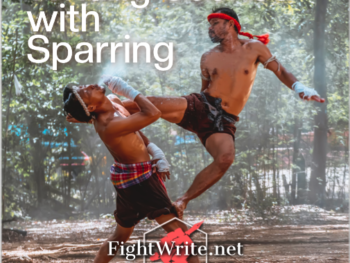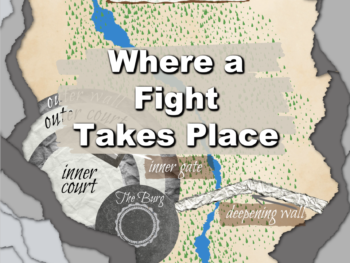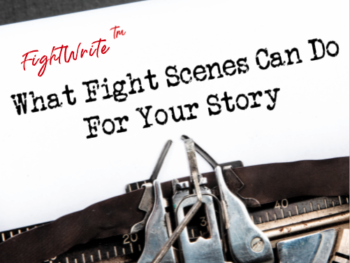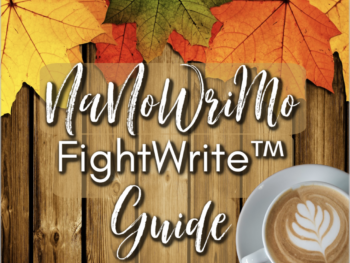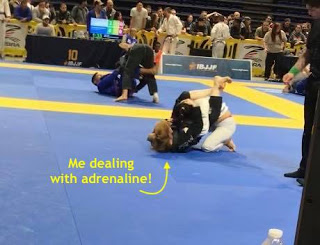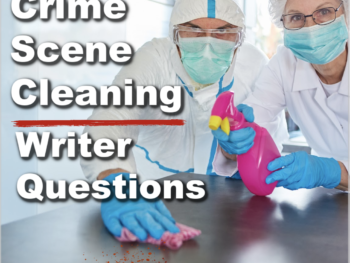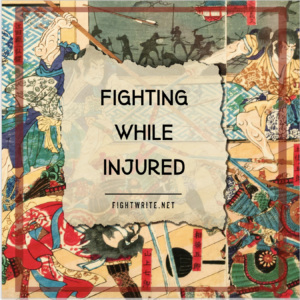 Where there is a fight, there’s generally an injury. And, if you are writing fight scenes, chances are you will have to write a fight scene with injured characters. When that is the case, there are things you have to think about before you even consider the wound. I did a short IGTV post on this very subject.
Where there is a fight, there’s generally an injury. And, if you are writing fight scenes, chances are you will have to write a fight scene with injured characters. When that is the case, there are things you have to think about before you even consider the wound. I did a short IGTV post on this very subject.
A lot of what I will cover is in my book, so be sure to check it out. It’s available online tons of places as well as in brick and mortar shops and your local library. And, before you go, subscribe to the blog for a handy guide to bleeding out, stages of death and decomposition, access to subscriber’s only posts and a discount code for my current and classes to come with Writer’s Digest University.
Ok, now, on to the question! First, you can absolutely fight while wounded…well, mostly…sometimes…it depends. Obviously, we have to consider the severity of the wound. But, as well, we have to consider a few other things that pertain to the fight, the wound and your characters.
What to Consider Other than the Wound
Setting of the Work
The setting of your work will determine the biology of your character, where your work is in time, where the fight takes place and if magic is involved.
Biology
Does your character have normal, human biology? If not, how your character’s body works is something you and your reader must know. Your reader can discover these characteristics through the course of the story, but you have to know them from the start. Know what takes your character out of commission. It’s ok if you can’t kill them. Just know what compromises them or at least traps them.
Time
The era in which your work takes place determines the technology which, in turn, determines the type of weaponry present. It may be that the weapon used exceeds the technology of the rest of the story. A character may travel back in time or be from a planet with superior scientific knowledge. If that is the case, know what that weaponry does to the body. If you want a character to survive, that superior technology can’t be beyond the scope of the inferior medical care. In other words, sure, have a crazy weapon. But don’t make its impact something that the doctors of that time can’t handle.
The weaponry also determines how able your character is to fight on. I can fight on with a gun far longer than I can a sword for the simple fact a gun takes little movement and effort. If I am bleeding, my best bet is to lie down, raise the injured area above the heart and stay still and calm. I can’t do that if my weapon/fighting style is one that requires strength, much movement or the ability to simply stay on my feet.
Site
Where your character is when they are injured can help or hinder them. If they are located in an area that allows them buffers, they may have a better chance of continuing on. Perhaps that buffer will allow them to take their assailant by surprise or simply afford them a chance to rest and/or tend to their wound before resuming the fight.
Magic
When writing fight scenes with magic, know the limits of it. Like the biology of the character, your reader can find out the limitations of the magic in time. But, in order for you to write a fight scene and a character wounded by magic, you have to know what that magic does to the body. A character can’t fight on if magic has paralyzed their body unless the paralyzed character also has magic and can fight with their mind. Ya got to figure out all that out and keep up with it because, let me assure you, your readers will.
Situation
The circumstances around the wounding matter as much as the wound itself. If the wound is the result of a surprise attack, adrenaline may not have a chance to do its “thang.” Adrenaline’s job is to keep us alive. Two of the many ways it does this is by enhancing clotting ability, which lessens blood flow and, ultimately, blood loss, and by lessening the pain response. If your character is injured while fighting, they will reap the benefits of adrenaline more so than if they are taken by surprise. Also, the proper mental state allows a character to better use adrenaline as well.
Wound
I am ever amazed at what the human body can take. Don’t assume because someone is injured that they aren’t deadly. I have read accounts of people stabbed in the heart who have run 20 feet before collapsing. People are deadly until they are dead. How long they remain deadly depends upon the wound, the overall physical health of a character and their mental state as well.
Know what the weapon in your work does to the body. For example, a bullet doesn’t just kill because it breaches the body. The energy that fires the bullet does extensive damage as well. That said, sometimes a bullet passing all the way through the body does less damage than one that remains lodged for the simple fact the energy of the bullet isn’t absorbed by the body. When it is absorbed, that energy blooms and just wrecks the organs. In fact, sometimes the bullet isn’t as deadly as the energy that delivers it. So, know your damage. I have several posts on that sort of thing.
General Health
The health of a character before they are wounded will affect their performance after they are wounded. A character who is already physically compromised by age, illness or disability before their body is injured may not have the strength or stamina to fight on.
Mental State
If your character has extensive combat training, they may be able to stay more calm despite their injuries and simply have a mindset that rebuffs death. Can mindset keep a character alive when they have mortal injuries? No. But it can keep death at bay a bit longer than if the character just decides to give up.
In the book, Lone Survivor: The Eyewitness Account of Operation Redwing and the Lost Heroes of SEAL Team 10 , Navy Seal Marcus Luttrell recounts the wounding of his teammate Petty Officer 2nd Class Matthew G. “Axe” Axelson. Axe was shot several times including in the head. The latter was so severe that blood filled his eye sockets, turning his eye balls black.
Nevertheless, Axe was still talking and kept firing to allow Luttrell to escape. There is evidence that Axelson, despite devastating injury, crawled some distance away from where Luttrell last saw him. Although his wounds would have certainly killed him given the time, Axe was dispatched by an enemy combatant’s bullet to the back of his head. We don’t know if he was unconscious when killed but we know that he was still alive. If you have not read that book, do. It is…well, I’m having a hard time putting words to it. It will amaze you, break your heart and give you a glimpse into the power of the human spirit.
When considering the mental state of a character, we have to consider whether or not they are on drugs. If so, you should know the effects of that drug. A character on meth is going to be far more physically dangerous and active than a character high on marijuana. Meth is a stimulant. Marijuana is not.
Injury Basics
Pain, Blood, Swelling and What You Can’t Fight Through
Pain
When you are writing your fight scene, remember that adrenaline impacts the pain response differently for everyone. It is absolutely possible for someone for a character to be gravely injured and not know it. Some folks have been shot/stabbed and had no clue. I interviewed a man for my book who had been stabbed in the chest and was completely unaware. But, just as well, there are some people who absolutely knew they had been injured and were in excruciating pain. So, whatever you write pain-wise for a character is probably correct because there is such a spectrum of pain sensitivity. What is absolutely true across the board is that pain increases as adrenaline ebbs.
For those who don’t feel their injury, seeing it may cause the pain associated with it to register. Case in point, UFC fighter Jon Jones. In this clip, we see Jon Jones break his toe. 🤮 Best we can tell, he’s clueless to the fact. In this clip, we see that he is in enough discomfort that his attention goes to his foot. When he sees that first little piggy taking a hard right turn, his discomfort turns to pain. At one point, he puts his hands over his stomach as if sickened. Before he covers his stomach, he crosses his arms over his chest. That’s important.
Research has shown that along with meditation, swearing (serious as %$#@ on that) and breathing techniques, crossing the arms over the chest can lessen the pain response. When you cross your arms, your brain gives attention to the new “map” of the body and doesn’t process pain stimuli as well. Strange but true.
Injuries that produce automatic responses
There are some injuries with which a character cannot fight for the simple fact the body won’t allow it. A stab to kidney is so painful it sends the body into shock. A liver punch causes the injured to drop into a fetal position. And any strike that lands with enough force to disrupt blood pressure can knock a combatant out cold.
What always holds true
In daily life and in writing fights scenes, keep in mind that in a life or death situation, there are no rules. You and your characters must do what it takes to survive no matter how brutal. Go for the eyes to blind. Strike the throat to kill. If your injured character has a blade, target the abdominal aorta. Yes, your defending character can target the heart. But if their strength is compromised, they may not be able to breach the ribs. The abdominal aorta is vulnerable from beneath the sternum to the belly button.
Targeting the abdominal aorta also allows the character to strike without lifting their arm as high. That gives them the ability to better guard their own chest and abdomen. If the target’s clothing is too thick to breach, your injured character could go for the neck or face with their blade. Both of these are smaller targets and require the wielder to lift their arm higher neither of which are optimal. But, the defender will likely move automatically. We just do that when things fly at our face. Their movement, while protecting the face and neck, may open other targets on their body.
DO NOT FORGET that the injury, of all characters, has to fit the work. Above all, serve the story. If a character needs to function in later chapters, do not wound them mortally or beyond the scope of the medical care available. This is why I always advise to block the fight around the injury, even if that injury doesn’t happen. First and foremost, it makes you consider the injury you want. You have to know from the start of the scene how far you want it to go.
If you don’t want the fight to go to the death, then the stakes of the confrontation need to be lower, or you need to give your injured character a way out. If you give your injured character no options, and their life is on the line, they will have to kill their assailant in order to make it out of the scene.
Now, let’s look at blood and swelling. I will categorize the wound scenario and then strategy. If it is something that can work in the favor of your wounded character, there will be a 👍 . If it works against them, there is a 👎 . We will also look at offensive and defensive tactics.
🩸 Bloody wounds
Everyone reacts differently to the sight of their own blood. It emboldens some fighters and disheartens others. Thing is, in close combat, sometimes a fighter doesn’t know if the blood on them is theirs or their opponent’s. So, what can begin as joy in believing an opponent has been compromised can turn to shock when a fighter discovers the blood is their own. I have seen fighters who, after the fight, find injuries on their bodies and seem completely confused by them. And, so help me, the more confused they are by the wound, the more they poke it!!!
Blood has a metallic taste and if there is enough of it, you can smell it as well. As it coagulates, blood darkens, becomes sticky then flakey. Dried blood on the skin can looked like cracked paint.
Head wounds bleed a lot. The same wound on another part of the body will bleed less. A bleeding wound on the scalp can cause hair to mat up. It looks very red at first. I’ve seen blood on very dark hair still have a bright red hue. It all depends on the amount of blood lost.
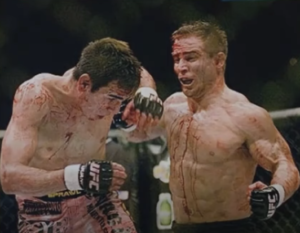 Blood that mingles with sweat becomes watery and drips more. It seems to stay red longer too. Also, when blood mingles with sweat, it looks like there is more of it. The pic at right is a link to some very bloody UFC fights. You’ve been warned.
Blood that mingles with sweat becomes watery and drips more. It seems to stay red longer too. Also, when blood mingles with sweat, it looks like there is more of it. The pic at right is a link to some very bloody UFC fights. You’ve been warned.
Lastly, the percentage of blood lost is more important than the actual amount. I talk about that in this post and in my book. A person who weighs more will have more blood. So, a pint of blood lost has a lesser impact on a 200lb fighter than a 100lb fighter.
Strategy
👍 Being bloodied can work to your fighter’s advantage, provided of course that the loss of blood isn’t enough to compromise them. First, some folks just don’t want to engage with a bloodied opponent. This can be especially true if a blood borne pathogen is present. Second, it can be tough to hold on to a bloody opponent just like it is a sweaty one.
👎 On the down side of bleeding, your character is bleeding! Even when not life threatening, bloody wounds can cause impediments to efficient fighting. If blood is flowing from my brow into my eye, my vision is hindered. If my hand is wet with blood, I may lose grip on my weapon. If it flows onto the floor, I may slip.
Flowing blood that can’t be seen is a bigger problem. When blood from a broken nose flows down the throat – and it often does – it hampers breathing and can cause a fighter to choke. Swallowing blood can make a fighter sick to their stomach as the body can’t digest raw blood. Also, if your character has a broken nose they should NOT blow it. It could cause the eye(s) to swell up shockingly fast.
Internal bleeding puts pressure on organs causing extreme pain. It is also impossible to staunch the flow of internal bleeding from the outside. So, your character can’t do quick first-aid to keep fighting.
Offense
Your attacking character would do well to target bleeding wounds. The area is likely swelling which makes it even more vulnerable to a larger laceration. The more profound the cut, the more the defender is compromised. If the opponent’s vision is compromised because of blood running into the eyes, the attacker would want to move more toward their opponent’s blind side. They must keep in mind however that a skilled opponent will still be able to judge distance and could land a productive strike. So, the attacker needs to keep a safe distance. Moving toward the blinded side of a combatant causes the fighter to turn their head more which could open their face and neck to strikes.
Defense
If blood is flowing into their eye(s), your injured character should not allow their opponent to move into their blind spot. This may mean they have to move a little more. In this fight UFC fighter Nate Diaz has a cut on his brow. This isn’t uncommon for him as he has prominent brow bones. You can see the extent of the cut above his eye at 29:22. The cut on the cheek below the left eye isn’t an issue. But, as a southpaw fighter, a cut above the right eye means that Diaz’ lead side is a bit compromised. You see his opponent, Connor McGregor, run to Diaz’ blind side at 38:40. By the way, if you want an example of a brawler, a fighter who will just slug it out, Nate Diaz is your man. Always bet on Nate Diaz.
🎈 Swelling
Swelling is the first step to healing. It’s the result of the body sending white blood cells to the injured area. That swelling puts pressure on nerves and causes pain to keep the fighter from using the injured body part even more and risking further injury. That nerve compression can be severe enough to make it seem as though there is a break in the bone. I took an ax kick to my forearm once and the swelling compressed the nerves so badly that I couldn’t use my hand. (For the record, don’t block a kick with the forearm. Do as I say not as I do!) My arm was misshapen and looked and felt broken.
As with other injuries, adrenaline can mitigate swelling. But, even with less swelling, use of the injured part can be compromised. Within a minute of taking the kick to the arm, my entire arm was weaker.
I notice swelling on my face while I’m still fighting more so than swelling on my body. When your brow is swollen, your top eye lid doesn’t open as wide. When there is swelling on the cheek, the bottom of the eye rides up like you are squinting. However, your character may not register pain with either. The “heartbeat” sensation in the area is more noticeable after adrenaline ebbs. By the way, if your character’s eye is black, they shouldn’t blow their nose immediately. It could worsen swelling.
Strategy
👎 There’s no up side to swelling. It’s a thumbs down all around. Swelling on the face can impede vision. Swelling on the body can hinder movement. Internal swelling is extremely painful and can hinder breathing. Adrenaline will slow the swelling. After the fight, when adrenaline ebbs, that injury can swell up big time especially if the fighter continued using the injured area.
Offense
Wherever your attacking character sees a weakness, they should capitalize on it. If their target has a limp or seems in pain, the aggressor should make them move preferably toward the area of swelling. If the opponent is limping on their right foot, the aggressor should move to that right side.
Defense
A lot of this will depend on the extent of swelling. If the swelling impedes fighting at full capacity, the injured character should try and put a buffer between them and their opponent. If they can’t, they should fight with an intensity that keeps the stakes of the fight in mind. (See above What holds true.)
Okeedoke. Check back soon for tactics for writing fight scenes with specific injuries. Until then, you’re awesome, you complete me, get blood on your pages!!!



